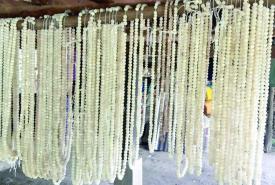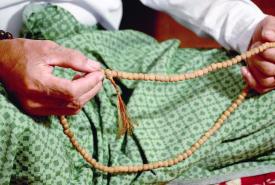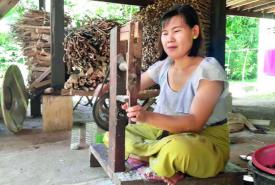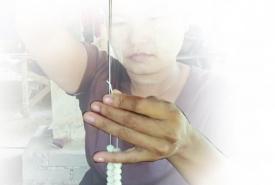By Thet Oo (Thaton)
MYANMAR'S markets and bazaars teem with a remarkable variety of native handicrafts, with stalls displaying lacquerware, metalwork, brass and marble sculpture, woodcarvings, embroidered textiles and more.
Another great place to hunt for souvenirs are the shops which line the stairways leading into the many Buddhist pagodas. These specialise in quintessentially religious paraphernalia, from incense to mini Buddhas and prayer beads.
Most of the hand-made souvenirs and religious paraphernalia come from rural areas of the country. Made of materials as diverse as wood, crystal, and precious gems, and strung together in varying sizes and quantities,
The beads themselves can be made from wood, depending on the focus of the birthday of the prayer. For example, one who born in Monday is advised by astrologers to use a string of beads made from palm wood.
Prayer beads made of rattan fruits in Thaton, Mon State
Making prayer beads from fruits of rattan trees is a traditional domestic business for the folk people in the Village of Zayitchaung in Thaton Township, Mon State.
The bead making process begins with collecting rattan fruits from nearby regions in the rainy season (in May) when the trees produce fruits.
To turn the fruits to beads, they are dried under the sun and boiled, and turn them into balls with a machine. A maker can produce about 20 garlands of prayer beads with 108 number of balls.
After stringing the balls, the makers put them on finishing touches.
The customers are from the souvenir shops from pagodas in other regions.
Prayer Beads Construction
The standard construction of Buddhist prayer bead consists of 108 number of beads with each string in like a garland. The material of the bead may vary according to one’s preference. The number of beads can also vary from 18 to 9.
Some decades back in time, many Buddhist Monks in Myanmar and lay persons carry their “Prayer Beads” called in Burmese “Seik Pa De”– when they are on pilgrimage or visiting monastery.
The prayer beads is a symbol of living a virtuous life style. Looking at the history of Prayer beads –Seik Pu Ta– meaning restraining one’s mind using the beads could achieve concentration of a single point.
It is strictly considered as Samatha(Concentration) Practice and is not a Vipassana practice.
Prayer beads are a traditional tool in Buddhism and are especially common among Buddhists. The beads are commonly used to count the recitation of the Nine Supreme Qualifications of the Buddha.
Buddhist prayer beads can be as beautiful as they are powerful. Symbolizing important Buddhist concepts, these beads not only serve a role in rituals, but also feature prominently in paintings and sculptures of Buddhist teachers and deities.-GNLM







